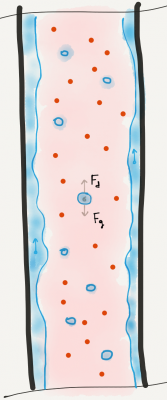Liquid loading
Brief
Liquid loading is a phenomenon when the gas phase does't provide sufficient transport energy to lift the liquids out of the well.
In 1969 Turner et al. published an empirical correlation defining the Liquid loading gas velocity.
Math & Physics
The minimum gas velocity to remove the liquid equation:
The minimum gas rate to remove the liquid equation:
Discussion
To avoid the Liquid loading the gas velocity should be above the Liquid loading velocity.
The higher the gas rate the higher the gas velocity.
The lower the wellhead flowing pressure the higher the gas rate.
The bigger the tubing ID the higher the gas rate.
In case when the gas rate is limited by the Reservoir deliverability smaller tubing ID will increase the gas velocity.
Nomenclature
 = flow area, ft^2
= flow area, ft^2 = flowing wellhead pressure, psia
= flowing wellhead pressure, psia = gas rate, MMscf/d
= gas rate, MMscf/d = gas density, lbm/ft3
= gas density, lbm/ft3 = liquid density, lbm/ft3
= liquid density, lbm/ft3 = surface tension, dyne/cm (ref values: 60 - water, 20 - condensate) [1]
= surface tension, dyne/cm (ref values: 60 - water, 20 - condensate) [1] = flowing temperature, °R
= flowing temperature, °R = gas velocity, ft/sec
= gas velocity, ft/sec = gas compressibility factor at flowing P & T, dimensionless
= gas compressibility factor at flowing P & T, dimensionless
References
- ↑ 1.0 1.1 Turner, R. G.; Hubbard, A. E.; Dukler (Nov 1969). "Analysis and Prediction of Minimum Flow Rate for the Continuous Removal of Liquids from Gas Wells"
 . Journal of Petroleum Technology (SPE-2198-PA): 1475–1482.
. Journal of Petroleum Technology (SPE-2198-PA): 1475–1482.



